 I learned about the culture of the early 20th Century at my mother’s knee (& other low places. Her favorite joke.) . The stories she told me about my grandmother, born in 1888, growing up on the farm, & the fascinating tales of her own life & times, combined beautifully with my own old-timey nature & held me securely me in those periods as others are anchored to the generation of their birth.
I learned about the culture of the early 20th Century at my mother’s knee (& other low places. Her favorite joke.) . The stories she told me about my grandmother, born in 1888, growing up on the farm, & the fascinating tales of her own life & times, combined beautifully with my own old-timey nature & held me securely me in those periods as others are anchored to the generation of their birth.
Not surprisingly, I have always lived in an old house & I always felt a special kinship with it, but it wasn’t until I owned my first home that I learned the concept of stewardship & became curious about- no, actually compelled to start researching the history of my bungalow & discovering its secrets.
A building is a composite of the culture & technology of its day. A custom-built home tosses in the tastes & lifestyle of the homeowners. Who were they? What inspired them? How did the house serve their needs? So, let’s make those walls talk!
BE PREPARED!
 My suggestion for keeping the maze of information easy to follow is to start by creating a system in which to keep your research orderly because you could end up with many pages of documents, both hard & digital. Set up a dedicated hard file & a digital one in your computer in which to stash your finds.
My suggestion for keeping the maze of information easy to follow is to start by creating a system in which to keep your research orderly because you could end up with many pages of documents, both hard & digital. Set up a dedicated hard file & a digital one in your computer in which to stash your finds.
You might also want to create a spreadsheet to make a map of your data so you know where you’ve been. In this you would have such columns such as the document name, its date, publisher, your source & a space for notes & most importantly, where can it be found in your hard or digital files. Each piece or group of information can lead to the next so you want to keep your clues untangled!
GETTING STARTED RESEARCHING THE HISTORY OF YOUR BUNGALOW
Are you in a historic district, or has your house been designated as a historic structure? (This information should have been disclosed to you when you purchased your house because these designations often come with restrictions, but, sometimes there are surprises!) If so, the designating planning body should have information about it. Even if you are not, your house could have been part of a historic survey at one time so check with your city & state preservation offices.
OLD HOUSE GROUPS
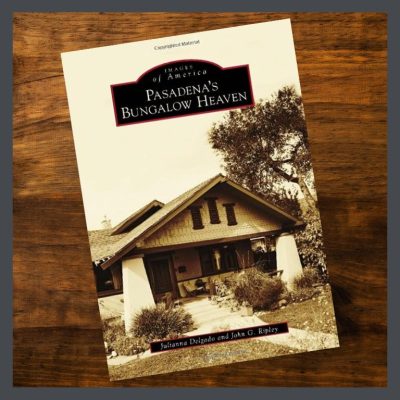 Your local historic society can often provide a great deal of information from their archives. Also, see if there’s a preservation advocacy group near you & enlist their aid. Even if they don’t have information about your specific house, they will be able to provide you with a great deal of information on your city, maybe even on their website! I recommend being connected with & supporting these groups. If you are an old house lover, they’re your peeps!
Your local historic society can often provide a great deal of information from their archives. Also, see if there’s a preservation advocacy group near you & enlist their aid. Even if they don’t have information about your specific house, they will be able to provide you with a great deal of information on your city, maybe even on their website! I recommend being connected with & supporting these groups. If you are an old house lover, they’re your peeps!
Arcadia Publishing publishes well-researched, beautifully illustrated books detailing historic cities & neighborhoods.
”For over 20 years Arcadia Publishing has reconnected people to their community, their neighbors, and their past by offering a curbside view of hometown history.
Composed in a unique pictorial format with over two hundred vintage images and accompanying captions, Arcadia books animate the cherished memories, people, places, and events that define a community.”
The next place to start is your own observations. Does the layout make sense? Are there indications of add-ons? This can confuse records because sometimes a build date can be listed as the date a later addition was permitted. I’ve seen houses that were clearly built close to the turn of the last century with recorded build dates that were post WW II.
In researching the history of your bungalow, look around your neighborhood. Are their houses that look similar? Talk to your neighbors & ask what research that they have done. They may have made discoveries that would enrich with what you are seeking.
One interesting factor is to notice how your house & the surrounding houses, orient to one another. In my neighborhood, you can clearly see what was the original farmhouse. Much older than the other houses, it faces what is now a big city street, with its back door facing the rest of the neighborhood. Most neighborhoods began as farming communities & in researching the history of your bungalow, you’ll find that the story of your local neighborhood forms a large chapter in the history of your own house.
THE BUNGALOW HISTORY RESEARCH PAPER TRAIL
 Know this- the older your house is, the more changes could have occurred with regard to its location- street numbers, street names, even town & city names & borders. And, the house itself could have been moved maybe just blocks or even many miles! So pay attention to any oddball changes you might see as you are doing your research- those facts that don’t line up. For example, an odd build date can reflect a house move. You don’t want to be researching the history of the house that was demolished to make room for your house! I’m sure the lives of its inhabitants are worth knowing about, but it’s not what you’re after! This Folk Victorian that I restored (You can see the sad tale here.) had been moved from another neighborhood to make room for a highway project. It was weird to do research for a different address but at least I knew that it had come from another location & I had the correct original address for it.
Know this- the older your house is, the more changes could have occurred with regard to its location- street numbers, street names, even town & city names & borders. And, the house itself could have been moved maybe just blocks or even many miles! So pay attention to any oddball changes you might see as you are doing your research- those facts that don’t line up. For example, an odd build date can reflect a house move. You don’t want to be researching the history of the house that was demolished to make room for your house! I’m sure the lives of its inhabitants are worth knowing about, but it’s not what you’re after! This Folk Victorian that I restored (You can see the sad tale here.) had been moved from another neighborhood to make room for a highway project. It was weird to do research for a different address but at least I knew that it had come from another location & I had the correct original address for it.
Additionally, public records can be incomplete or inaccurate due to human error, floods & fires destroying decades of information & illegible from age or just terrible hand-writing. Your search is not likely going to be linear, but more cobbled together like a puzzle, as you search for like pieces from different sources that form bits of the whole picture, some contradicting other materials & some validating it. This is why you want to keep those records in good order when researching the history of your bungalow!
HOME OWNERSHIP RECORDS
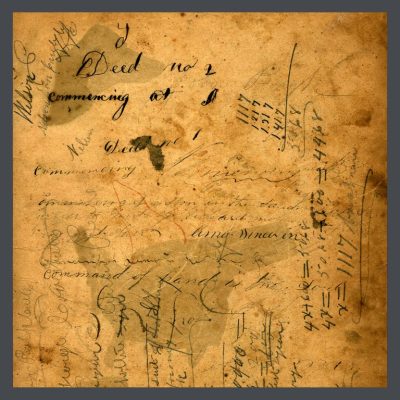 Visit your local county’s Tax Assessor’s office which will provide ownership records & descriptive information. You may have to go to a separate location to view archived records, or perhaps they will be helpful to find them for you & bring them to the office.
Visit your local county’s Tax Assessor’s office which will provide ownership records & descriptive information. You may have to go to a separate location to view archived records, or perhaps they will be helpful to find them for you & bring them to the office.
Next, head to the county courthouse to search for deeds & follow ownership backward. Take notice of how the property may have changed hands- liens, judgements, inheritance, etc. & you may need to check other records such as civil courts or wills to get more of the story.
The building department may have records of permits. Sadly, they do not generally go back very far, but sometimes you can be surprised. You may be told that the records you seek are not digitized but are archived. Very pleasantly request access to these records. You may need to be persistent in doing this!
Then, with all your information, head for your local public library. I can almost guarantee that you will find at least one librarian there who is a local history expert & she will happily point you in the right direction to flesh out your data. Local colleges & universities can also provide a wonderful amount of material as well as friendly & enthusiastic librarians who hold much data in their heads.
CITY DIRECTORIES
 The Library of Congress’s collection of telephone/city directories represents the following states and localities: Alabama, Alaska, Arizona, Arkansas, California, Colorado, Connecticut, Delaware, the District of Columbia, Florida, Georgia, Hawaii, Iowa, Maryland, Pennsylvania, and the city of Chicago. Most local libraries will have these directories to many local ones, covering most of the 20th Century also.
The Library of Congress’s collection of telephone/city directories represents the following states and localities: Alabama, Alaska, Arizona, Arkansas, California, Colorado, Connecticut, Delaware, the District of Columbia, Florida, Georgia, Hawaii, Iowa, Maryland, Pennsylvania, and the city of Chicago. Most local libraries will have these directories to many local ones, covering most of the 20th Century also.
Many of these directories are arranged geographically, in other words, by street name, so you can look for your address in any particular year’s edition & see if was included. This is often very helpful in discovering the year your house was built. In one volume you’ll see it. Checking earlier, you won’t!
THE SANBORN MAPS
 These maps were created to allow fire insurance companies to assess their total liability in urbanized areas of the United States. Founded in 1866, the company made maps of churches, schools, commercial, industrial & residential properties. These maps are helpful for determining build dates & also footprints of houses, including outbuildings. They also show the locations of windows & doors, building use (sometimes even particular room uses) as well as the composition of building materials including the framing, flooring, & roofing materials.
These maps were created to allow fire insurance companies to assess their total liability in urbanized areas of the United States. Founded in 1866, the company made maps of churches, schools, commercial, industrial & residential properties. These maps are helpful for determining build dates & also footprints of houses, including outbuildings. They also show the locations of windows & doors, building use (sometimes even particular room uses) as well as the composition of building materials including the framing, flooring, & roofing materials.
These maps can be accessed via the Library of Congress & through many local libraries. They are very beautiful. so, old house nerd that I am, I have saved some of the most lovely ones for you here on Pinterest.
There are also general maps that can be accessed from Old Maps Online. A fun feature of this site is that you see the evolution of a place by overlaying old maps on top of modern ones to compare historical maps to current data. This provides a visual clue to the development of areas over time.
CENSUS RECORDS
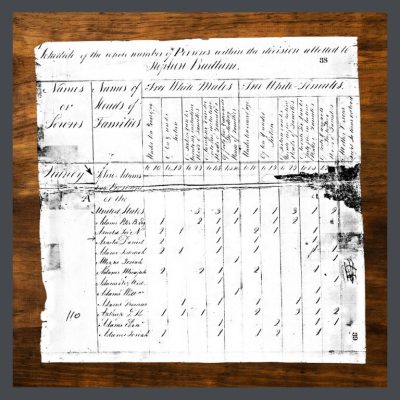 Another great tool is census records which paint a detailed picture of each person living in the house. For example, the 1910 (my favorite year) census records the following information for each person:
Another great tool is census records which paint a detailed picture of each person living in the house. For example, the 1910 (my favorite year) census records the following information for each person:
• name
• relationship to head of household
• sex
• color or race
• age at last birthday
• marital status
• length of present marriage
• if a mother, number of children & number of living children
• place of birth
• place of birth of parents
• if foreign born, year of immigration and citizenship status
• language spoken
• occupation
• type of industry employed in
• if employer, employee, or self-employed
• if unemployed
• number of weeks unemployed in 1909
• ability to read & write
• if attended daytime school since September 1, 1909
• if home is rented or owned
• if home is owned, free, or mortgaged
• if home is a house or a farm
• if a survivor of Union or Confederate Army or Navy
• if blind in both eyes
• if deaf & dumb
This data can be accessed through the National Archives, but your local library can probably help you with it too.
NEWSPAPERS
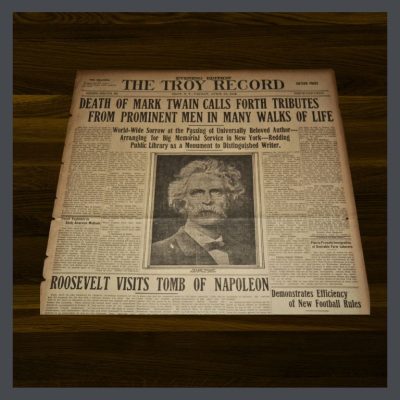 NewspaperArchive provides links to millions of pages from 12,111 publications in 2,671 papers all over the U.S., starting way back in 1736.
NewspaperArchive provides links to millions of pages from 12,111 publications in 2,671 papers all over the U.S., starting way back in 1736.
They gather information from libraries, historical societies, & newspaper publishers, amassing content that will help you find the stories that will further your research on your bungalow.
The search can be arduous, but poking around on the site I discovered that Reverend Alfred Hare, the builder of the Hare house, played the guitar & was very active in the social life of my town, Eagle Rock, as well as participating in community betterment activities. I also found the obituary of his wife’s father. In general, I was able to get a good idea of the lives & characters of the Hare’s & gain a greater understanding of the some of the puzzling features of the house. And fell more in love with them.
I also got an idea of how life had been in my town around 1910. The funny thing is, it hadn’t changed all that much! It was still centered around our cultural center, which had been a Carnegie Library, & the 20th Century Women’s Club, to which I belonged in the 21st Century.
PLAN BOOKS
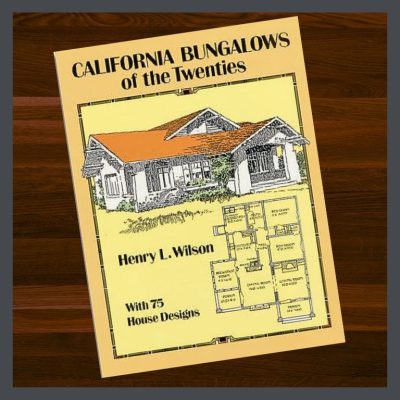 A large number of bungalows were built from plan books, many of which can be accessed here. Instead of drafting whole new blueprints, builders would adapt these plans to the lot & to clients’ needs. Many people believe that they have kits houses because they see so many houses that are similar, but what they actually have is a home built from a plan. There was even a self-proclaimed “Bungalow Man,” Los Angeles architect Henry L. Wilson, who published catalogues of bungalow designs, complete with plans & specs for $10.00. Many of them are unique to the California landscape, providing a broad broad view of bungalow designs of the region, expressing what Wilson termed “artistic beauty & cozy convenience.”
A large number of bungalows were built from plan books, many of which can be accessed here. Instead of drafting whole new blueprints, builders would adapt these plans to the lot & to clients’ needs. Many people believe that they have kits houses because they see so many houses that are similar, but what they actually have is a home built from a plan. There was even a self-proclaimed “Bungalow Man,” Los Angeles architect Henry L. Wilson, who published catalogues of bungalow designs, complete with plans & specs for $10.00. Many of them are unique to the California landscape, providing a broad broad view of bungalow designs of the region, expressing what Wilson termed “artistic beauty & cozy convenience.”
This book was reprinted by Dover, is available on Amazon & other book outlets & especially should you live in California, I recommend it highly.
GENEALOGY & OTHER WEBSITES
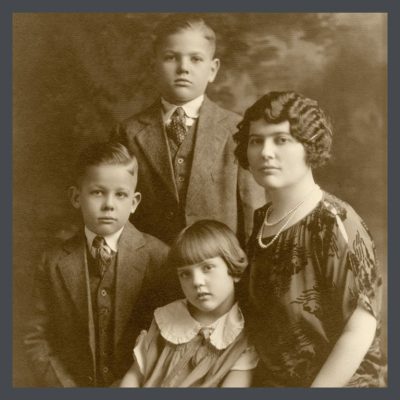 You will find many names as you are looking through the above sources. (Luckily, you have jotted them in your well-organized, copious notes.) You can plug these names into these sites to find out more & can even help you locate living relatives. Some of these folks will be happy to speak with you & might even have old images.
You will find many names as you are looking through the above sources. (Luckily, you have jotted them in your well-organized, copious notes.) You can plug these names into these sites to find out more & can even help you locate living relatives. Some of these folks will be happy to speak with you & might even have old images.
Ancestry, an American genealogy company has an enormous database. To access their information from home, you have to pay fees, but, most libraries allow you to access all their data for free from the library’s computers. The advantage to doing from the library is that you have the reference librarians nearby who love helping people find the answers to all their questions.
Find a Grave is another site that offers a huge amount of information, including names of relatives relatives & often brief bios.
Please let me know about any other great resources you might discover. I’m very eager to know what your walls tell you!
TIP: I put together a collection of very informative videos to further orient you to the research process. You can watch them here.
STAY IN THE BUNGALOW KNOW!!!
Sign up for our newsletter & receive our FREE E-book, 7 VITAL Things to Do Before You Hire a Contractor.




Awesome…!thanks so much!
Glad you liked it! Let me know what you find out!
This will definitely be fascinating to do. I’m always asking people. I met a woman who grew up in my house in the 70s and 80s, and there was a lot of brown paneling, brown doors and brown trim. It used to have a back screened porch where the refrigerator was. There was a mudroom that you walked into by the front door with a bench. Then from there you could walk through a door and enter the formal living room to see the wood paneling. The stairs to the upstairs room/attic were in the dining room. All of these features are completely gone. I’m pretty sure my bungalow did not have the stunning bungalow woodwork. My neighbors do! It is definitely a working man’s semi – bungalow.
Yes, I think that you’ll enjoy it. You’re a good researcher so you’re going to be quite successful at it!
I agree that archive.org is great for all the old catalogs. I could spend hours looking at them! I found that the collection from Building Technology Heritage Library was a particularly good collection for home books and other historic home resources. https://archive.org/details/buildingtechnologyheritagelibrary
Yes, it is an amazing resource! I will include it. Thank you!